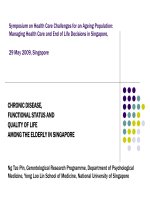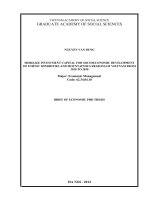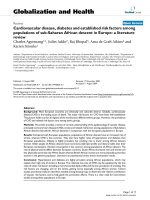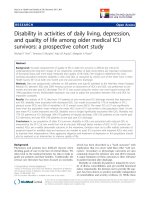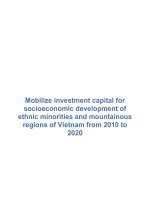Knowledge and experiences of abortion among adolescent girls in asia a scoping review from 2010 to 2020
Bạn đang xem bản rút gọn của tài liệu. Xem và tải ngay bản đầy đủ của tài liệu tại đây (361.96 KB, 14 trang )
JOURNAL OF MEDICAL RESEARCH
KNOWLEDGE AND EXPERIENCES OF ABORTION AMONG
ADOLESCENT GIRLS IN ASIA: A SCOPING REVIEW
FROM 2010 TO 2020
Nguyen Thanh Hang, Nguyen Dang Vung
Hanoi Medical University
It has been estimated that 5.6 million abortions occur each year among adolescent girls aged 15 - 19
years, of which 3.9 million are unsafe. The situation in Asia is particularly complicated compared to other
regions due to the distinction in socio-cultural characteristics. This study aimed to describe abortion
knowledge and experiences of adolescent girls in Asian countries in the period 2010 - 2020. Among 22
included publications, 41% of the studies were conducted in South-East Asia. The percentage of girls lacked
knowledge and had improper perceptions of abortion could be as high as 95.7%. Common reasons for
abortion were health conditions and socio-economic pressures, such as poverty and the need to maintain
social self-sufficiency. Medical and surgical abortion was common, and while many girls went to hospitals and
legitimate health providers, some did it themselves or went to clandestine abortion. Physical complications
included menstrual disorders, pain, fever, vaginal bleeding or even septic shock, while feeling guilty and
stressed was flagged as emotional consequences. To improve the situation of teenage abortion in Asia,
adolescents should be provided with adequate knowledge on abortion laws and care, parents should be
more open to this issue and governments should consider permitting legal abortion among adolescents.
Keywords: adolescent girls, abortion, Asia, knowledge, attitude.
I. INTRODUCTION
Adolescents are not a homogenous
population. The shift from childhood to
adulthood leads to dramatic physical, sexual,
psychological and social changes, particularly
in adolescent girls. At this stage in their lives,
girls are particularly sensitive and vulnerable
physically as well as mentally. In addition to
development opportunities, there are health and
wellness risks associated with this transition.1
Every year, an estimated 21 million girls aged
15 - 19 years in developing regions become
pregnant. Meanwhile, it has been estimated that
Corresponding author: Nguyen Thanh Hang
Hanoi Medical University
Email:
Received: 15/07/2021
Accepted: 22/08/2021
JMR 148 E9 (12) - 2021
5.6 million abortions occur each year among
adolescent girls aged 15 - 19 years, of which
3.9 million are unsafe, contributing to maternal
mortality, morbidity and lasting health problems.
This number accounts for almost 18% of the
total global incidence of unsafe abortion (22
million), and abortion-related mortality among
young girls and women accounts for nearly
one-third of abortion-related deaths worldwide.2
The situation of abortion Asia is particularly
complicated compared to other parts of the
world due to the distinction in socio-cultural
characteristics. In such oriental culture as the
majority of Asian countries, there is a high
level of stigmatization associated with outof-wedlock pregnancies and this accounts
for the most common reasons of terminating
a pregnancy in Asia. In addition, abortion,
especially for adolescents or unmarried young
165
JOURNAL OF MEDICAL RESEARCH
women, are illegal in many nations in Asia.1 As a
result, young girls and especially those who are
unmarried, seek abortions in clandestine and
unsafe conditions fearing being turned away for
menstrual regulation.1 Having an abortion at a
very young age with an immature body, along
with the risk of exposure to unsafe abortion,
those adolescent girls are likely to suffer from
medical complications, as well as psychosocial
consequences such as depression and suicidal
ideation, or worst, mortality.3,4
There have been previous studies reviewing
the abortion-related issues among teenagers
around the world. In 2015, Wellisch and Chor
conducted a study to review statistics about
teenagers and abortion, explain the different
types of abortion available to teenagers, and
discuss aspects of abortion unique to the
adolescent population in the United States.5
Meanwhile, abortion practices in Africa, its
consequences, and control strategies among
adolescents were described in a review
published in 2019.6 On the other hand, a
scoping review by Zulu et al. presented the
understanding about the ethics context of post
abortion care research with adolescents.7
Therefore, it is necessary to tackle abortion
among adolescents as well as improve the
quality of abortion care for this population. A
summary of understanding and updates on
the current situation of teenage abortion in
the Asian societies are critical for rational and
prompt decision-making of the health sector.
This study thus aimed to describe abortion
knowledge and experiences of adolescent girls
in Asian countries in the period 2010 - 2020.
II. METHODS
1. Study design
This study is a scoping review.
2. Search methods for identification of
studies
The search strategy was performed on
166
PubMed/Medline and ProQuest with the
restriction for year of publication from 2010
to 2020. Search strategy was conducted by
combining different terms for “adolescent girls”,
“abortions” and name of Asian countries. In
order to form a complete search strategy, the
terms were combined using Boolean operators
(AND, OR and NOT). A limit for year of
publication from 2010 to 2020 was also applied.
2. Selection of studies and management
All studies downloaded from databases were
extracted in a two-stage process. In the first
stage, titles and abstracts of all search results
were screened. Papers were excluded if they 1)
had no specific data for adolescent girls, 2) had
no specific data for Asian countries, 3) did not
cover our outcomes of interest (knowledge and
experience of abortion), 4) was not written in
English, and 5) were not original research. The
studies that met selection criteria in the first stage
were then be downloaded in full text and moved
forward to the second stage. In the second
stage, all content of the selected studies in step
one was scanned. Peer-reviewed publications
in English published between 2010 - 2020 with
the outcomes of interest include the abortion
knowledge or experiences of adolescents aged
10 - 19 in Asia and related social factors were
selected. Study design of the selected studies
were cross-sectional study, qualitative study
and case reports.
3. Data extraction and analysis
A data extraction form was conducted
and applied to the selected studies. Data that
were extracted included (1) publication details
(authors, title, year of publication, etc.); (2)
country of study setting; (3) purpose; (4) study
design and sample size; (5) description of
participants; (6) methods and main findings.
The articles were categorized into thematic
areas based on the main findings found from
initial reading and organization of the articles.
JMR 148 E9 (12) - 2021
JOURNAL OF MEDICAL RESEARCH
4. Ethical consideration
This study utilized secondary data from public databases. Therefore, ethical consideration is not
applicable.
III. RESULTS
Figure 1 presents the process of selecting papers as well as the number of studies included and
excluded of each step. The primary literature search on the databases identified 586 papers. A total
of 564 publications were excluded due to duplication, being reviews/protocols for clinical trials/book
chapters/conference abstracts, not focusing on adolescent girls, outcome of interest not related to
Included
Screening
Identification
abortion and not being written in English.
Records identified
from:
PubMed (n = 461)
ProQuest (n = 125)
Records removed
before screening:
Duplicate records
removed
(n = 90)
Records screened
(n = 496)
Records excluded
(n = 418)
Reports sought for
retrieval (n = 78)
Reports not retrieved
(n = 18)
Reports assessed for
eligibility (n = 60)
Reports excluded:
No specific data for
adolescent girls
(n = 12)
No specific data for
Asian countries
(n = 6)
Outcome of interest
not mentioned
(n = 9)
Not article/original
research (n = 11)
Studies included in
review (n = 22)
Figure 1. Selection of studies
The included studies were conducted mainly in South-East Asia, India and China. The majority of
participants were unmarried schoolgirls. Among the included studies, there were 6 studies involved
research on abortion knowledge of adolescent girls and one third of them came from Malaysia (Table
1). Results from the publications showed that while a large number of adolescents were aware of
complications and legality of abortion, many had minimum knowledge and inappropriate perception
about abortion.8-12
JMR 148 E9 (12) - 2021
167
168
Adolescents aged 13 - 18 years from selected East 7.5% of female respondents had correct responses for knowledge on
Malaysian secondary schools, had no abortion
Malaysian abortion law
Adolescent girls who were still in school, had no abortion, 95.7% of respondents had minimum knowledge about the concept of
had no abortion
abortion, shown by inappropriate perception such as abortion could
be done on an unmarried couple, or for those who were at school and
unable in rear a child. Another misconception was indicated through the
statement that abortion could be performed by non-health workers.
29 young women in their teenage years from deprived All participants said they had heard of experiencing complications,
backgrounds in Hong Kong, had at least one abortion
including serious pain, heavy bleeding, the uterus not being “cleaned
out” and the threat of infertility, though they had never attempted to verify
the information. Risks to physical health and post-abortion stress from
illegal abortions were either due to their own experiences or picked up
from media reports and the experiences of peers.
Pregnant adolescents aged between 12 and 18 in a Most of the adolescents (84.6%, 22) knew abortion is illegal in Malaysia.
government shelter home, had no abortion
23
12
8
10
Knowledge
Unmarried subjects requesting termination of pregnancy Approximately half the adolescents had no knowledge of the stage in
and having abortion
pregnancy up to which termination was possible.
Description of participants
11
Study
Table 1. Findings of studies on knowledge of abortion among adolescent girls in Asia
JOURNAL OF MEDICAL RESEARCH
JMR 148 E9 (12) - 2021
9
Study
Knowledge
In- and out-of-school female adolescents, had no abortion 31.5% of respondents were aware of induced abortion. Most of these
participants (78.6%) agreed a person should have an abortion where
to continue the pregnancy would endanger a woman’s life, or in the
case of rape (62.3%); where there was a fetal abnormality (74.6%);
the women was single (57.9%) or to continue her study (62.7%).
Of participants who had heard of abortion, 47.6% had a high level of
knowledge, with females having a higher knowledge scores than males
Only a few participants (12.5%) knew medical abortion or substances
that could be taken to induce abortion, although females knew more
than males (18,6% vs. 10.6%, respectively). Those aware of medical
abortion methods cited tablets inserted vaginally (43.2%), boiled roots
(29.7%), beverages (27%), painkillers/antibiotics (Cafenol, Panadol,
ampicillin, aspirin, Anadin) (16,2%), Misoprostol/Cytotec (10.2%), and
physical removal (8.1%).
Description of participants
JOURNAL OF MEDICAL RESEARCH
JMR 148 E9 (12) - 2021
169
170
11
15
Study
trimester.
termination of
trimester:
in
the
aspiration.
Guilty due to the belief that abortion
was a sin
future
made it possible in
to maintain their trimester had
social standing.
requesting
termination of
pregnancy (> 1)
first
trimester
in the second
any stage, 2
no delay at
the
and a termination
experienced
terrible
distress
guilty about it, these young people
wanting to have sex and feeling
protected
subjects
their who came for
The
abortion 8 adolescents Tertiary care hospital
consequences
Emotional / Physical
Post-abortion
Because of the conflict between
the
methods
in
Prostaglandins
reported
vacuum
medical
reported
Hysterotomy: when all methods failed
second
subjects
manual
trimester:
subjects
of abortion
Sources + Methods
Unmarried
pregnancy (> 1)
in the second and
requesting
For
for termination first
72% reported For
of abortion
Time point
subjects
abortion
participants
Unmarried
Reasons for
Description of
Table 2. Findings of studies on abortion experiences of adolescent girls in Asia
JOURNAL OF MEDICAL RESEARCH
JMR 148 E9 (12) - 2021
Experienced
unsafe abortion
Adolescent girls
<15, 15 - 19
24
Description of
participants
16
Study
Reasons for
abortion
JMR 148 E9 (12) - 2021
Sources + Methods
of abortion
Vaginal misoprostol suppository was the
most common method.
Surgical procedure for attempted
unsafe abortion more frequency
induced
severe
complications
Chemical injection through the vagina
and uterine evacuation method were the
most common method used to induce
severe complications
Timing
of
abortion for
< 15 is at a
much later
stage than
that for older
women.
Time point
of abortion
Bleeding (48.7%) and pain (36.9%)
were the common symptoms
in all methods, the majority of
women who had fevers used the
intrauterine chemical injection
Retained conceptive product was
the most common complication
in women with unsafe abortions
(74.7%), 68 cases had pelvic
infection, 18 cases received
blood transfusions, six cases had
acute renal failure, 10 cases had
hypovolemic shock, seven cases
had septic shock, and two cases
had sepsis with disseminated
intravascular coagulopathy.
Post-abortion
Emotional / Physical
consequences
JOURNAL OF MEDICAL RESEARCH
171
172
Pregnant
teenager mothers
having abortion
requests to the
Legal Medicine
Organization of
Fars province,
Shiraz
29 young
women in their
teenage years
from deprived
backgrounds in
Hong Kong
8
Description of
participants
13
Study
Poverty was one
of the primary
reasons for the
young women’s
decisions to abort
Thalassemia of
the fetus (78.6%)
M a t e r n a l
cause (22.4%):
halassemia,
Chronic disease,
Depression,
ypertension
Reasons for
abortion
Time point
of abortion
3 used illegal abortion services in Hong
Kong, 4 used services in mainland
China, 2 used herbal medicines
prescribed by Chinese medical doctors
in Hong Kong and had successfully
aborted. 17 abortions took place in
public hospitals while 5 were in private
hospitals, 2 at a non-profit youth health
clinic. The proportion of illegal abortions
among the 29 women was 27.3%.
Sources + Methods
of abortion
They also associated post-abortion
feelings of stress with illegal
services that had poor facilities and
poor hygiene
Post-abortion
Emotional / Physical
consequences
JOURNAL OF MEDICAL RESEARCH
JMR 148 E9 (12) - 2021
JMR 148 E9 (12) - 2021
Girls of the age
group of 10 - 19
years residing in
urban slums
18
Adolescent
female sex
workers
25
Reasons for
abortion
Mainly socioeconomical
(86.8%): being
single, financial
issues, and not
ready to start a
family.
Women who
underwent
induced
abortions
14
Study
Description of
participants
74.7% in the
first trimester
and 25.3% in
the second
trimester
Time point
of abortion
Post-abortion
Emotional / Physical
consequences
Among 136 had abortions, 74
(54%) reported ever experiencing
complications, including menstrual
disturbances (39; 29%), discharge
(32; 24%), pain (29; 21%), fever
and vaginal bleeding (5; 4%) and
uterine perforations (1; 0.7%).
83.1% abortion done in hospital by
registered medical practitioner and
16.9% were done locally by local person
and no clear data regarding incidental
abortion
Half (50%) of induced abortions were
performed at a public hospital; the
remainder were private hospitals/clinics
(30%), family planning clinics (17%), or
using take-home medication (3%).
Sources + Methods
of abortion
JOURNAL OF MEDICAL RESEARCH
173
174
17
Study
(1) an out-of
school urban
adolescent
sample; (2)
a vocational
school student
sample; and (3)
a general school
and university
student sample.
Description of
participants
Reasons for
abortion
Time point
of abortion
Around 1/3 of respondents went to a
private clinic or hospital for their most
recent abortion. About 1/4 had a friend
help by buying illegal abortifacients, and
almost 1/5 had induced the abortion
themselves, mostly after buying illegal
abortifacients. Less than 1/10 had
sought help by going to public health
organizations, which normally did not
provide abortion services unless there
were strong medical reasons that
threatened the pregnant woman’s life.
Only a few reported visiting traditional
healers for abortions.
Sources + Methods
of abortion
5.3% reported minor complications
with no need for medication, 14.5%
reported
minor
complications
with medication obtained from
a pharmacy, and 9.0% reported
severe complications requiring
treatment at a clinic or hospital.
Those who had been associated
with
self-induced
abortions,
however, were more likely to report
minor complications treated with
pharmacy medications, or severe
complications requiring clinic or
hospital treatment, while those
who had gone to private clinics
or hospitals for (illegal) abortions
tended to report no complications
at all, or only minor complications
with no need for any advanced
treatment
Post-abortion
Emotional / Physical
consequences
JOURNAL OF MEDICAL RESEARCH
JMR 148 E9 (12) - 2021
JOURNAL OF MEDICAL RESEARCH
Table 2 shows 11 studies examining abortion
experiences of adolescent girls who had at
least one abortion. The studies presented some
aspects of abortion experiences, including
reasons for abortion, time point of abortion,
sources and methods of abortion, and postabortion consequences. Common reasons
reported were health conditions and socioeconomic pressure, such as poverty and the
need for social standing maintenance.8,13,14 In the
9 studies that examined sources and methods
the burden of early motherhood. This especially
applies to young teenagers, many of whom
are unmarried and still attend school full-time.
Poverty, the fear of losing social standing and
pressure from families were other common
reasons for abortion. For younger adolescents,
pregnancy is more likely resulted from rape,
incest, or transactional sexual activity, which
further stimulates abortion among girls. On the
other hand, this review found that adolescents
tend to delay an abortion into the second
of abortion, the use of medical and surgical
abortion was common, and while many girls
went to hospitals and legitimate health providers,
some carried it out by themselves.8,11,15-17 In
terms of consequences, the complications
range from menstrual disturbances, pain, fever,
vaginal bleeding to as severe as septic shock,
and feeling guilty and stressed was reported as
emotional consequences.11,16-18
trimester, due to limited knowledge of and access
to safe abortion services, delayed recognition
of pregnancy status, fear and shame of going
to the hospital, scared to tell their parents, and
did not know where to go for medical help.15,18
The situation also implies a lack of knowledge
on recognition of pregnancy among adolescent
girls.
However, given the social context in Asian
countries, where premarital sex and teenage
pregnancy is a taboo, it is such a surprise
that we did not find shame and stigmatization
as reasons for termination of pregnancy. A
research from UNICEF about adolescent
pregnancy in Asia-Pacific has indicated
that cultural and religious sensitivities were
reasoned for the shame and depression of
young girls who become pregnant.19 In terms
of cultural prejudgments, communities in many
Asian countries harshly criticize unmarried girls
who had premarital sex. The stigmatization is
more severe for adolescent pregnancy, which
can be regarded as a determinant of clandestine
abortion among this group. Abortion which
is not to save a woman’s life is forbidden in
Indonesia. Despite the laws, qualitative studies
among various groups indicated that abortions
before marriage are becoming more prevalent
among young adults in this country. According
to a consultancy report for the Sustaining
IV. DISCUSSION
This review sheds light on knowledge and
experiences of abortion among adolescent
girls in Asian countries from 2010 to 2020. Our
findings show that many young girls lacked
knowledge and had inappropriate perceptions
about abortion. Common reasons reported
were health conditions and socio-economic
pressure, such as poverty and the need for
social standing maintenance. Medical and
surgical abortion was common, and while many
girls went to hospitals and legitimate health
providers, some carried it out by themselves.
Physical complications range from menstrual
disturbances, pain, fever, vaginal bleeding
to as severe as septic shock, while feeling
guilty and stressed was reported as emotional
consequences.
Adolescents give some reasons for seeking
an abortion, including the willingness to continue
their education or to protect their future from
JMR 148 E9 (12) - 2021
175
JOURNAL OF MEDICAL RESEARCH
Technical Achievements in Reproductive Health
(STARH) Program, there are roughly 2 million
abortions conducted in Indonesia yearly, 30%
of which are associated with adolescents.20
Vietnamese adolescent girls who get pregnant
are often scorned, looked down by society and
their families are likely to bear a bad reputation
later on. In 2019, according to figures from the
Vietnam Family Planning Association, between
20 and 30% of abortions are unmarried women
and between 60 and 70% are students, mainly
environmental characteristics that determine
their abortion experience. In addition, we only
included studies written in English, which
cannot cover the entire literature on this topic in
Asian settings.
Findings of the current study give rise to
some implications for practice, policy and
future research. Since abortion knowledge of
Asian young girls reported in this study was
either insufficient or inaccurate, providing this
population with more educational programs
between the ages of 15 and 19. About 20%
of these people are teenagers. This number
shows that Vietnam is the fifth largest country in
the world and the largest country in the SouthEast Asia region in terms of abortion.21
When adolescents end up attempting an
abortion, many try to do it themselves by
ingesting herbal or chemical preparations,
inserting objects into the vagina or seeking
traditional healers. Adolescents’ resources
and access to health care are more limited
in comparison with older counterparts, which
hinders general healthcare-seeking behavior
among adolescents, in particular around
sexual and reproductive health needs (such
as contraceptives, antenatal care, etc.), and
exacerbate delays in seeking abortion care.22
Meanwhile, complications stemming from
unsafe abortion are one of the leading causes
of death among adolescent girls in LMIC,
which may be due to the fact that adolescents
tend to delay abortion care until the second
trimester.15,18
There are several limitations to this review.
First, out of the 586 articles, we were only
able to locate 22 full-text versions for review
due to resource constraints. Furthermore,
this review examines findings from a variety
of Asian countries; however, adolescents in
each context have unique personal, social or
on abortion policies and post-abortion care
as well as general reproductive health is of
great importance. Moreover, in cultures where
premarital sex and teenage pregnancy is a
taboo such as many Asian countries, parents
should be more open-minded and help their
children overcome the unwanted situation
safely. In terms of policies, laws that prohibit
teenage abortion are preventing adolescent
girls from accessing safe and qualified
healthcare providers, which might in turn
result in post-abortion complications and other
dangerous health consequences. Therefore, a
question is raised that whether it is appropriate
or not to retain the policy banning teenage
abortion in the current society. Future research
should investigate attitudes of parents towards
teenage abortion and points of view of parents
whose children experiencing abortion during
adolescence.
176
V. CONCLUSION
Findings of this study show that many
young girls in Asia lacked knowledge and
had inappropriate perceptions about abortion.
Common reasons reported were health
conditions and socio-economic pressure, such
as poverty and the need for social standing
maintenance. Medical and surgical abortion was
common, and while many girls went to hospitals
and legitimate health providers, in countries
JMR 148 E9 (12) - 2021
JOURNAL OF MEDICAL RESEARCH
where teenage abortion is illegal, some girls
carried it out by themselves or went to unqualified
clandestine abortion. Physical complications
range from menstrual disturbances, pain, fever,
vaginal bleeding to as severe as septic shock,
while feeling guilty and stressed was reported
as emotional consequences. In order to tackle
teenage abortion in Asia, not only adolescents
should be properly equipped with adequate
reproductive health knowledge, but this public
health issue also requires effort from families
abortion for teenage women from deprived
backgrounds in Hong Kong. Reprod Health
Matters. 2010;18(36):102-10.
9.Vongxay V, Chaleunvong K, Essink DR,
Durham J, Sychareun V. Knowledge of and
attitudes towards abortion among adolescents
in Lao PDR. Global Health Action. 2020;13.
10. Tan P, Tohid H, Su X, Tan K, Azimah
M, Khairani O. A study on pregnant adolescents
residing in a government home: common
characteristics and their views on the pregnancy.
and governments.
Malays Fam Physician. 2012;7(1):11-5.
11. Sowmini CV. Delay in termination of
pregnancy among unmarried adolescents and
young women attending a tertiary hospital
abortion clinic in Trivandrum, Kerala, India.
Reprod Health Matters. 2013;21(41):243-50.
12. Djuwitaningsih S, Setyowati. The
Development of an Interactive Health Education
Model Based on the Djuwita Application for
Adolescent Girls. Compr Child Adolesc Nurs.
2017;40:169-182.
13. Ghodrati
F,
Saadatmand
N,
Gholamzadeh S, Akbarzadeh M. Investigation of
the prevalence and causes and of legal abortion
of teenage married mothers in Iran. Int J Adolesc
Med Health. 2018;32(1).
14. Lim L, Wong H, Yong E, Singh K.
Profiles of women presenting for abortions in
Singapore: focus on teenage abortions and late
abortions. Eur J Obstet Gynecol Reprod Biol.
2012;160(2):219-22.
15. Prabhu TR. Legal abortions in the
unmarried women: social issues revisited.
Journal of obstetrics and gynaecology of India.
Jun 2014;64(3):184-8.
16. Srinil S. Factors associated with severe
complications in unsafe abortion. J Med Assoc
Thai. Apr 2011;94(4):408-14.
17. Tangmunkongvorakul A, Banwell C,
Carmichael G, Utomo ID, Sleigh A. Birth control,
REFERENCES
1.World Health Organization. Adolescent
health in the South-East Asia Region. https://
www.who.int/southeastasia/health-topics/
adolescent-health.
2.Jacqueline E. Darroch VW, Akinrinola
Bankole, Lori S. Ashford. Costs and Benefits
of Meeting the Contraceptive Needs of
Adolescents. 2016.
3.World Health Organization. Adolescent
Pregnancy. 2015. />bitstream/handle/10665/204765/B5164.
pdf?sequence=1&isAllowed=y .
4.World Health Organization. Preventing
unsafe abortion. />5.Wellisch L, Chor J. Adolescent Girls and
Abortion. Pediatr Ann. Sep 2015;44(9):384-92.
6.Atuhaire S. Abortion among adolescents
in Africa: A review of practices, consequences,
and control strategies. Int J Health Plann
Manage. Oct 2019;34(4):e1378-e1386.
7.Zulu JM, Ali J, Hallez K, Kass N, Michelo
C, Hyder AA. Ethics challenges and guidance
related to research involving adolescent postabortion care: a scoping review. Reprod Health.
May 2 2018;15(1):71.
8.Hung SL. Access to safe and legal
JMR 148 E9 (12) - 2021
177
JOURNAL OF MEDICAL RESEARCH
pregnancy and abortion among adolescents in
chiang mai, thailand. Asian Population Studies.
2011;7(1):15.
18. Gour R, Gandhi NK, Soni GP.
Assessment of reproductive health status of
adolescent girls of urban slums in Raipur city of
India. Drug Invention Today. 2019;12(10).
19. UNICEF EAPRO. Tackling the hidden
issue of adolescent pregnancy in Asia-Pacific.
presented at: UNICEF; 2014.
20. Situmorang A. Adolescent reproductive
health in Indonesia: Consultancy Report. 2003.
21. Mai T. Young people’s abortion alerts.
People News. />bao-dong-nan-pha-thai-o-nguoi-tre-349344.
22. Bright T, Felix L, Kuper H, Polack S.
Systematic review of strategies to increase
access to health services among children over
five in low- and middle-income countries. Trop
Med Int Health. May 2018;23(5):476-507.
23. Awang H, Low WY, Tong WT, et al.
Differentials in sexual and reproductive health
knowledge among east malaysian adolescents.
J Biosoc Sci. 2019;51(2):282-291.
178
24. Baba S, Goto A, Reich MR. Recent
pregnancy trends among early adolescent
girls in Japan. J Obstet Gynaecol Res.
2014;40(1):125-32.
25. Lim MSC, Xu-Dong Z, Kennedy E, et al.
Sexual and Reproductive Health Knowledge,
Contraception Uptake, and Factors Associated
with Unmet Need for Modern Contraception
among Adolescent Female Sex Workers in
China. PLoS One. 2015;10(1).
26. Zhang XD, Myers S, Yang HJ, et
al. Prevalence and correlates of sexual and
gender-based
adolescent
violence
women
who
against
are
Chinese
involved
in
commercial sex: a cross-sectional study. BMJ
Open. 2016;6(12):e013409.
27. Zhang X-D, Kennedy E, Temmerman
M, Li Y, Zhang W-H, Luchters S. High rates
of abortion and low levels of contraceptive
use among adolescent female sex workers in
Kunming, China: A cross-sectional analysis.
European
Journal
of
Contraception
&
Reproductive Health Care. 2014;19(5):368.
JMR 148 E9 (12) - 2021
